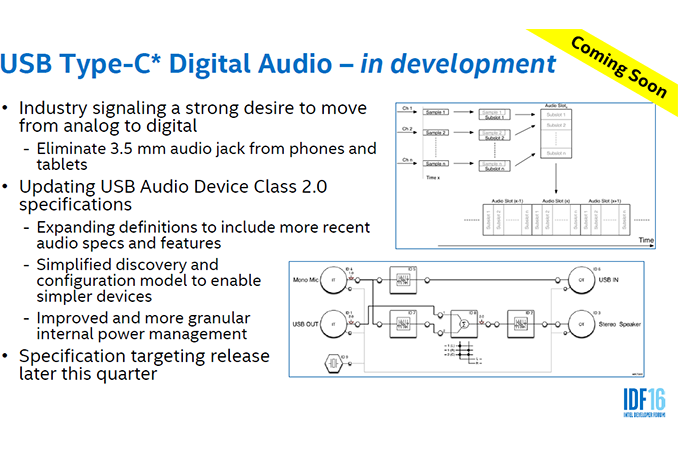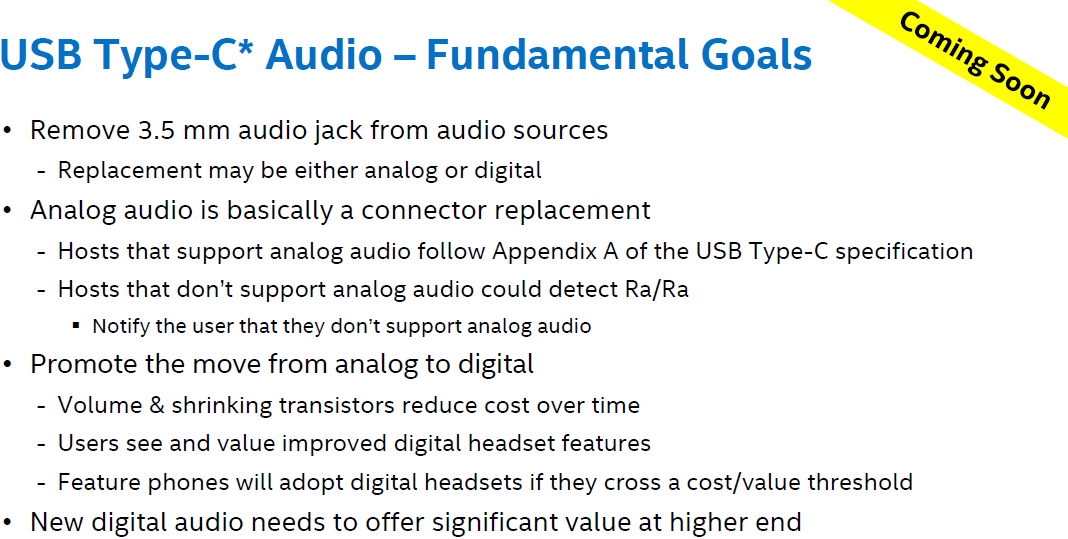Intel Proposes to Use USB Type-C Digital Audio Technology
by Anton Shilov on April 26, 2016 11:00 AM EST- Posted in
- Mobile
- Intel
- USB-C
- USB-C Digital Audio

USB Type-C has a number of chances to become the standard for data and charging connector for smartphones and tablets running either Android or Windows. However, in the long-term future, Intel wants USB-C to be even more universal (and therefore pervasive) than it is going to be, which is why at IDF Shenzhen part of one of the talks evolved around using Type-C for audio.
Audio receptacles on PCs and mobile equipment are virtually the last remaining analog interfaces of modern devices, requiring certain techniques to maintain a high audio quality and remove interference. Intel proposes to replace things like 3.5 mm mini-jack with USB Type-C which will help to add features to headsets and will simplify connections of multi-channel audio equipment to various gadgets. This is not the first time a company has proposed to replace analog audio on PCs and mobile devices, but so far, nobody has succeeded due to the ubiquity of 3.5mm. Since the industry may still not be ready to go all-digital, there seems to be a backup plan.
Various types of audio jacks to connect headphones to audio equipment have been around for decades. For example, the original 6.35 mm connector, which is still widely used by audio equipment, was invented in 1878. Meanwhile, two-conductor miniature 3.5 mm audio connector (which is the most widely used audio connector at present) has been around since 1960s. Headphone jacks have evolved; they have gained contacts to support microphones and even basic programmable capabilities to enable remote controls. However, fundamentally, the ability to listen to audio through a speaker has remained the same for over a hundred years: completely analog and barely any smart functionality. Today's smartphones are used for all sorts of different purposes and are connected to a variety of devices, which requires sophisticated interconnection technologies with high data-rates. At the same time, as phones and devices get thinner, or even to simplify some of the internal design, it gets harder to install multiple ports for various purposes. If there were to be a universal connector that does it all, including audio, Intel and some other players want USB Type-C to be that universal connector.
In fact, USB-C can be used to transfer analog audio in accordance with the specification of the connector. It all comes down as to how that audio is transmitted.
The USB-C has sideband use pins (SBU1 and SBU2) which can be used for analog audio in audio adapter accessory mode. Use of the sideband pins should not impact data transfers and other vital functionality of USB-C cables, which should make them relatively simple from the engineering point of view. In this case, the USB-C connector will just replace the 3.5 mm mini jack and may even gain some additional features, such as a thermal sensor in an earpiece could measure temperature for fitness tracking.
The concept is not completely new and we saw it years ago - back in the 2000s, Motorola used the mini-USB connector on its feature phones to enable charging, data transfers and a headset connection. The idea to use one connector for everything was not entirely bad, however, it left users without a choice of headsets. However, if the makers of devices (as well as producers of audio listening equipment) adopt USB-C, the is potential that the problem will not occur again. In the advent of digital signal transfer, this allows the headset to drive the digital-to-analog conversion, removing electronic interference from the host and potentially offering a wide array of audio results.
However, transferring analog audio using USB-C’s SBU pins is not the only thing that Intel is working on.
At present, Intel is finalizing the USB Type-C Digital Audio technology and plans to release its specification later in Q2. The company does not reveal a lot about the standard right now, but notes that it is working on updating the USB Audio Device Class 2.0 specifications to support new connector, expand the list of recent audio specifications and features, improve power management and simplify the discovery and configuration model to make the upcoming headsets as easy to use as today’s headsets.
In fact, one of the important issues with streaming audio over USB is the synchronization of data streams from the host to the receiver. The USB Audio Device Class specification solved the problem in the past and because Intel mentioned the USB Audio Device Class 2.0 in its presentation at IDF, this may mean that the new the USB-C Digital Audio spec will rely on this synchronization mechanism as well. Intel wants its USB-S Digital Audio to be backward-compatible with USB Audio (1.0 and 2.0), but naturally plans to add support for new music formats.
Usage of digital audio means that headsets should gain their own amplifiers, DACs and various other logic, which is currently located inside smartphones. Intel proposes to install special multi-function processing units (MPUs), which will perform beam forming, noise suppression, acoustic echo suppression (AES), acoustic echo cancellation (AEC), non-linear processing and other operations. The MPUs will also support HDCP technology, hence, it will not be possible to make digital copies of records using USB-C digital headset outputs. It is unlikely that audio processing will be offloaded to external headsets completely, but the latter will clearly gain their own chips. This may, however, see a spike in cost, especially at the super-low end.
A good thing about USB Type-C headsets with MPUs is that they are going to be software upgradeable and could gain functionality over their lifespan. Intel admits that such MPUs will make digital headsets more expensive compared to analog devices, but high volumes and new process technologies will help to reduce the cost of digital headsets over time. In fact, USB Audio headsets and audio chips for them are not something completely new. For example, Plantronics Audio 655 DSP headset costs $49.99, whereas CMedia’s HS-100 chip for headsets is available $1. Therefore, from the cost perspective, digital headphones should not be too much more expensive in general. Meanwhile, Intel wants USB-C digital audio headsets to offer “significant value at higher end” and have improved functionality in a bid to become popular among consumers.
The industry has successfully replaced analog cables with HDMI for video equipment in the living room and in the coming years will retire the D-Sub interconnection for computer displays. However, audio jacks have survived multiple generations as other standards have changed. In fact, Intel itself eliminated analog audio jacks in its first-generation NUCs PCs, but had to return them in subsequent generations. With USB-C Digital Audio Intel may not be alone. Google’s Android 5.0 already supports USB DAC devices and thus digital headsets. Moreover, last week LeEco released several smartphones without audio jacks, so, there are attempts to eliminate them from mobile devices already. One maker will not make any difference, but a coordinated move by market leaders, such as Samsung, LG or HTC, could have a significant impact.
Source: Intel



















148 Comments
View All Comments
BrooksT - Tuesday, April 26, 2016 - link
Yep -- it's a shame that 3.5mm audio gear was crippled for its entire life because some of us hung on to 1/4" devices. Sorry, everyone!ImSpartacus - Tuesday, April 26, 2016 - link
A passive adapter for 3.5mm and 1/4" is pretty simple & compact, right?But is it that easy to go from digital to analog (or vice versa)? Do you need an active adapter?
I'm not really an audio connoisseur, so I don't have an educated opinion on this stuff.
wolrah - Tuesday, April 26, 2016 - link
Quoting the article:"The USB-C has sideband use pins (SBU1 and SBU2) which can be used for analog audio in audio adapter accessory mode. Use of the sideband pins should not impact data transfers and other vital functionality of USB-C cables, which should make them relatively simple from the engineering point of view."
Any device could maintain their analog audio hardware and just eliminate the port, instead connecting it up to be yet another feature riding on the USB-C port. Adapters from such devices to a standard 3.5mm or other electrically compatible analog audio connections would be as cheap, simple, and dumb as DVI-I to VGA adapters. It's just changing the physical connector.
I'd imagine the transition would go pretty much the same as the various display connector changes have gone. New port shows up, some thin devices drop the old one and require adapters for use with most existing infrastructure. Eventually more native devices hit the market and the new port becomes relatively standard. At some point mainstream devices not crunched for space or cost start dropping the old port due to lack of use.
Look how long it's taken to kill VGA, and that's a port that should have been completely irrelevant after LCDs took over from CRTs.
brucethemoose - Tuesday, April 26, 2016 - link
Doesn't DVI have analog and digital variants?If so, that's the perfect comparison. VGA = 3.5mm, DVI-A = USB-C analog, DVI-D = USB-C digital.
Fergy - Wednesday, April 27, 2016 - link
@brucethemoose DVI is the perfect comparison: even though it can fully replace vga, vga is still provided just as much as DVI.Why do they want to eliminate 3.5mm so much? Would they give me 2 usb-c ports on the phone to compensate? How would that help them?
Murloc - Wednesday, April 27, 2016 - link
no DAC in the phone? Thinner port?ChuckDriver - Wednesday, April 27, 2016 - link
There has to be a DAC for the ear piece of the handset.brucethemoose - Thursday, April 28, 2016 - link
That's true... They could potentially use cheaper DACs if they skip USB analog output, but that's just shaving pennies off a device's BOM at best.BiggerInside - Friday, September 30, 2016 - link
(VGA->DVI connector comparison is valid, but unlike LCD screens which require a specific controller for each panel, we are all still using stereo analog speakers that are trivial to drive off an integrated DAC/amplifier. Where DVI allowed higher resolutions without distortion and noise, the change to digital audio gets us... Nothing.)Einy0 - Wednesday, April 27, 2016 - link
"Doesn't DVI have analog and digital variants?"Sort of... DVI-I carries a VGA analog signal over the same port as the digital signals. DVI-D only the digital signals.
It's still a decent analogy. DVI should have replaced VGA a long time ago but the standard refuses to die. I think this is a good thing. They should be able to make a simple passive adapter for type C to analog 3.5mm jack and if need be pass the rest of the type-c signals and/or power as well. It would ease the transition and pave the way for some fantastic headphones with built-in DACs/amps tuned for the speakers, etc...